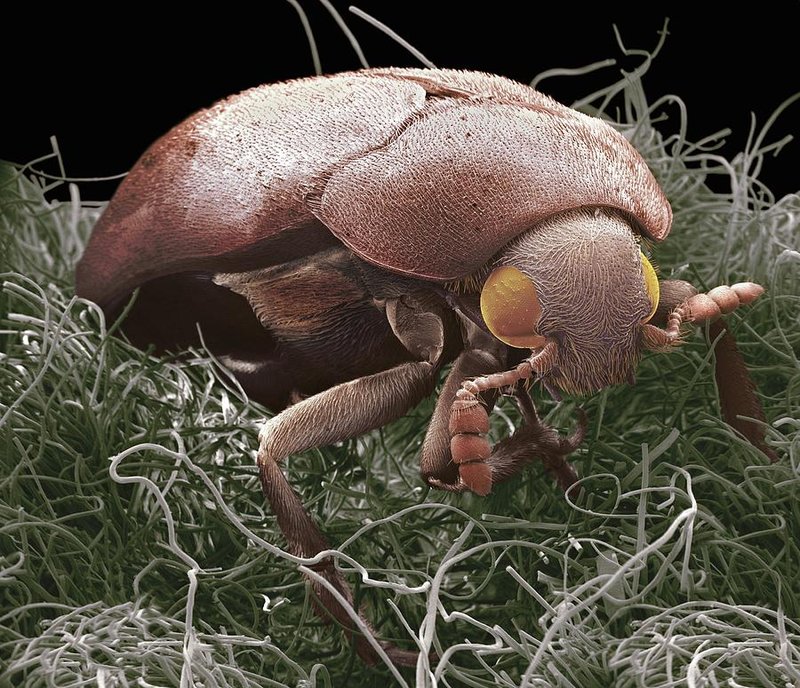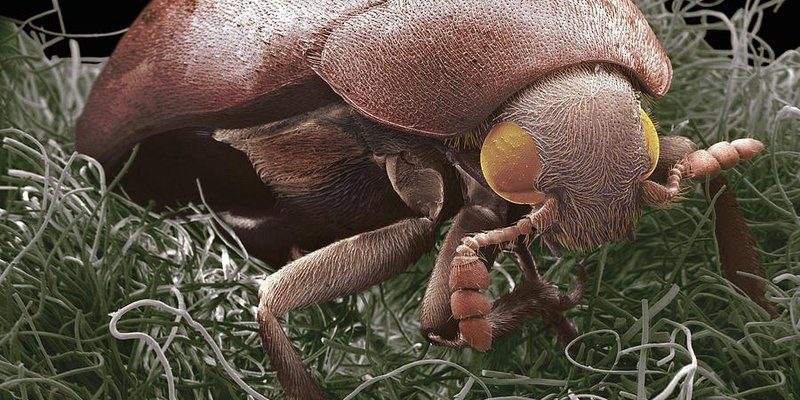
Introduction to Carpet Beetles
You might have heard of carpet beetles, but do you really know what they are? These tiny creatures, sometimes described as the uninvited guests of our homes, can be more fascinating than you think. Imagine a small insect that is often mistaken for a harmless bit of lint. But don’t let their size fool you! Carpet beetles can wreak havoc if given the chance—especially if you have a penchant for nice carpets, clothing, or other textiles.
Carpet beetles belong to the family Dermestidae, a group of beetles that are quite common around the world. They typically measure between 1/8 to 1/4 of an inch long, making them easy to overlook. You might find them fluttering around your house, inside your closet, or perhaps hiding in the dark corners of your home. But here’s the thing: understanding their habits and lifecycle can help you prevent them from turning into a bigger problem.
In this article, we’ll dive into the life of the carpet beetle. We’ll look at their characteristics, habitat preferences, what they eat, and how to deal with them if they decide to make your home their own. So grab a cup of coffee, and let’s explore the world of these peculiar little pests!
What Are Carpet Beetles?
Carpet beetles are small, oval-shaped insects that are known to munch on various materials. They can infest your home without you realizing it until it’s too late. The most common types are the black carpet beetle, varied carpet beetle, and furniture carpet beetle. Each has its unique coloring and size, but they share a common love for fabrics.
These beetles undergo a complete metamorphosis, which means they go through different life stages: egg, larva, pupa, and adult. The larval stage is particularly destructive, as the larvae feed on materials like wool, cotton, and even animal products. Think of these larvae as tiny carpet munchers, leaving behind a trail of damage.
You might be surprised to learn that adult carpet beetles are often found outdoors, especially in gardens and wildflower areas. They lay their eggs in dark, undisturbed places, like cracks in your furniture or behind your baseboards. When the eggs hatch, the larvae emerge and start their search for food—often right in your home.
Identifying Carpet Beetles
So, how do you identify a carpet beetle? First off, look for their size. Most carpet beetles are about 1/8 to 1/4 inch long. They usually have a rounded body, and you’ll notice some that are brown or black, while others may have a more varied coloring with yellow and white patterns. If they’re buzzing around your home, that’s a good sign you’ve got a carpet beetle issue.
The larvae are a different story. They are elongated and covered in fine hairs, often looking like little fuzzy caterpillars. If you see these little guys crawling around, that’s your cue to act. Their presence is usually accompanied by damage to fabrics, like holes in your clothes or carpets. So, keep an eye out!
To help you identify them better, here’s a summary of some interesting facts about carpet beetles:
| Size: | 1/8 to 1/4 inch long |
| Color: | Black, brown, or patterned with yellow and white |
| Life Cycle: | Egg, Larva, Pupa, Adult |
| Habitat: | Indoors, gardens, and wildflower areas |
| Diet: | Textiles, wool, cotton, leather |
| Lifespan: | Up to several months |
Where Do Carpet Beetles Live?
Carpet beetles thrive in various environments. You might find them in urban areas, rural homes, or even in the wild. Their principal hiding spots are dark and undisturbed places, making your closets, attics, and basements prime real estate. They love warmth and darkness, so if they find a cozy corner in your home, they’ll likely stick around.
Outside, these beetles are often found in gardens where they feed on pollen and nectar. It’s not uncommon to spot them flitting around flowers or collecting in piles of mulch. They can easily hitch a ride into your home through open windows or doors. That’s right—you could unknowingly invite them inside with a simple breeze.
To combat this, try to keep your home clean and well-organized. Regularly vacuuming and dusting can make a huge difference. You might think of it as rolling out the welcome mat for good bugs and keeping the pesky critters at bay.
What Do Carpet Beetles Eat?
Carpet beetles have a rather diverse diet. While you might expect a beetle to munch on leaves, these little guys have a taste for finer things—mainly your household items. They love natural fibers like wool, silk, and cotton, which means they’ll feast on your carpets, clothes, and even upholstery. If you have items made from animal products, like leather or fur, they may not be able to resist them either.
Interestingly, carpet beetle larvae are the true culprits behind the damage. As they grow, they need ample nutrition, leading them to munch their way through your beloved wardrobe. The adult beetles don’t do much eating—most of their time is spent looking for mates and laying eggs. It’s the larvae you need to look out for.
To protect your belongings, ensure that items are stored in airtight containers. Washing and dry-cleaning clothes periodically can deter these sneaky beetles. Trust me, a little extra care can save you from a lot of heartache later on.
How to Prevent Carpet Beetles
Preventing carpet beetles is all about being proactive. Start by keeping your home clean. Regular vacuuming will remove any eggs or larvae that may have settled in. Pay special attention to corners, under furniture, and areas that aren’t frequently disturbed. If you find the time, washing your clothes and linens regularly can also thwart any potential infestations.
Another good habit to adopt is to properly store items you don’t use regularly. Use plastic bins or vacuum-sealed bags for seasonal clothing or sentimental items. This makes it harder for the beetles to reach your beloved things. Additionally, consider checking any second-hand items—furniture or clothing—before bringing them into your home. You never know when a stray beetle might be hiding.
If you do catch a carpet beetle infestation early, you can usually handle it yourself. Try vacuuming thoroughly in affected areas and wash any textiles that may be infested. In some cases, you might want to look into pest control methods if the problem worsens.
Dealing with a Carpet Beetle Infestation
If you suspect an infestation, it’s essential to act quickly. Start by identifying the areas where you’ve noticed damage or where you’ve seen larvae or adults. Once you identify the hotspots, it’s time to clean. Vacuum those areas thoroughly—be sure to dispose of the vacuum bag or empty the canister outside to prevent any remaining beetles from re-entering your home.
Next, wash all affected fabrics using hot water. This will help eliminate larvae and eggs. If you have items that can’t be washed, consider placing them in the freezer for a few days. The cold can kill off pests without causing damage.
If the infestation seems severe or persistent, it might be wise to consult a pest control professional. They can assess the situation and provide you with effective methods to eliminate carpet beetles for good. It’s always better to nip this problem in the bud before it escalates.
FAQ
What attracts carpet beetles to my home?
Carpet beetles are attracted to warmth, darkness, and food sources. They often find their way into homes through open doors and windows or by hitching a ride on items like clothing or furniture. Once inside, they thrive on natural materials like wool, silk, and cotton, drawn to the scents or fibers present.
Can carpet beetles cause health issues?
While carpet beetles themselves aren’t dangerous, they can cause skin irritation in some people. Allergic reactions may occur if you come into contact with their hairs, which can lead to rashes or irritation. Generally, they are more of a nuisance than a health risk.
How long do carpet beetles live?
Carpet beetles have varying lifespans depending on their species and environmental conditions. In general, adult carpet beetles can live for several months up to a year. The larvae stage, which is the most damaging, can last for several months as well.
Do carpet beetles fly?
Yes! Adult carpet beetles can fly. They typically become more active in spring and summer, which is when you might notice them buzzing around your home. Their ability to fly makes it easier for them to move from outdoor areas into your home when they’re searching for sources of food.
What is the best way to get rid of carpet beetles?
The best way to get rid of carpet beetles involves a combination of cleaning and prevention. Vacuum thoroughly, wash affected fabrics in hot water, and store items in airtight containers. If necessary, consider using pest control methods or consulting professionals if the problem persists.
Can I use insecticides against carpet beetles?
Yes, insecticides can be effective against carpet beetles, but they should be used with caution. Always follow the instructions on the label, and consider opting for more natural remedies first, especially if you have pets or children in the home.
How can I tell if I have a carpet beetle infestation?
Signs of a carpet beetle infestation include noticing holes in your clothing or carpets, finding larvae, and spotting adult beetles. If you see any of these signs, it’s a clear indication that you need to take action to remove them from your home.
Are carpet beetles the same as bed bugs?
No, carpet beetles and bed bugs are different pests. While they both can invade your home, they have distinct habits and appearances. Bed bugs feed on blood and are typically found in beds, while carpet beetles feed on natural fibers and materials and can be found throughout your home.
Can I prevent carpet beetles without using chemicals?
Absolutely! Preventing carpet beetles can be done effectively without chemicals through regular cleaning, proper storage of textiles, and vacuuming. Additionally, washing materials frequently can deter these pests, keeping your home safe and pest-free.
What fabrics are most affected by carpet beetles?
Carpet beetles have a preference for natural fibers. They are particularly fond of wool, silk, and cotton. However, they can also feast on synthetic fabrics if they contain any natural fibers mixed in. Be vigilant with these materials to prevent damage.
Do carpet beetles only live indoors?
While carpet beetles are commonly found indoors, they also exist outdoors. They are often found in gardens and wildflower areas where they feed on pollen. However, they can easily make their way indoors if given a chance.

